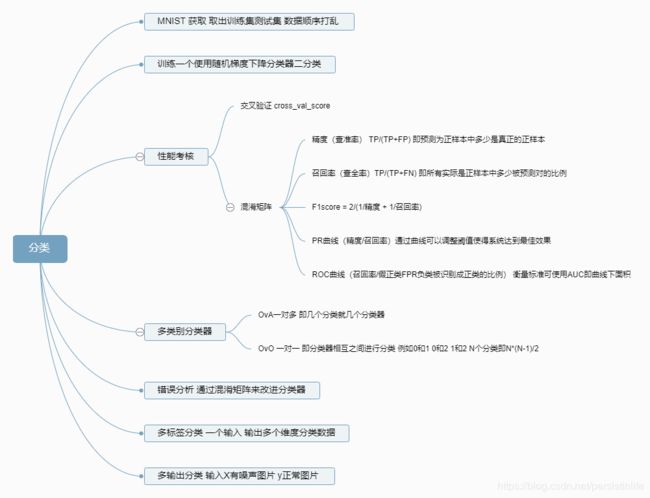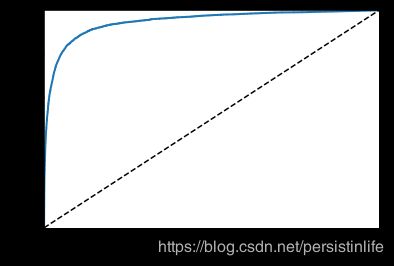机器学习实战(基于Sklearn和tensorflow)第三章 分类 学习笔记
机器学习实战 书籍第三章例子学习笔记
书中源码,here
本文地址,here
要分为Mnist数据处理、交叉验证、混淆矩阵、精度、多分类问题等。

加载数据 可以从本地下载
fetch_mldata下载较慢,可以下载到本地
链接:https://pan.baidu.com/s/1fAInuofJ_MJJfvNjY1djsg
提取码:e462
在当前工程目录下新建并拷贝自己下载文件
datasets/mldata/mnist-original.mat
其实从fetch_mldata源码里看到 是从这个目录下加载。

from sklearn.datasets import fetch_mldata
mnist = fetch_mldata('MNIST original',data_home='./datasets')
X, y = mnist["data"], mnist["target"]
%matplotlib inline
import matplotlib
import matplotlib.pyplot as plt
some_digit = X[36000]
some_digit_image = some_digit.reshape(28, 28)
plt.imshow(some_digit_image, cmap=plt.get_cmap("binary"), interpolation="nearest")
plt.axis("off")
plt.show()
X_train, X_test, y_train, y_test = X[:60000], X[60000:], y[:60000], y[60000:]
#打乱数据
import numpy as np
shuffle_index = np.random.permutation(60000)
X_train, y_train = X_train[shuffle_index], y_train[shuffle_index]
训练一个二分类器
y_train_5 = (y_train == 5)
y_test_5 = (y_test == 5)
from sklearn.linear_model import SGDClassifier
sgd_clf = SGDClassifier(random_state=42, max_iter=5, tol=None)
sgd_clf.fit(X_train, y_train_5)
sgd_clf.predict([some_digit])
性能考核
使用交叉验证测量精度
自定义分组
分成3组 每次取一组作为验证 总共三个输出
from sklearn.model_selection import StratifiedKFold
from sklearn.base import clone
skfolds = StratifiedKFold(n_splits=3, random_state=42)
for train_index, test_index in skfolds.split(X_train, y_train_5):
clone_clf = clone(sgd_clf)
X_train_folds = X_train[train_index]
y_train_folds = y_train_5[train_index]
X_test_fold = X_train[test_index]
y_test_fold = y_train_5[test_index]
clone_clf.fit(X_train_folds, y_train_folds)
y_pre = clone_clf.predict(X_test_fold)
n_correct = sum(y_pre == y_test_fold)
print(n_correct / len(y_pre))
from sklearn.model_selection import cross_val_score
cross_val_score(sgd_clf, X_train, y_train_5, cv=3, scoring="accuracy")
Never5Classifier这里返回全false 判断输入是非5 也就是输入任何数据准确率都可以达到90%
from sklearn.base import BaseEstimator
class Never5Classifier(BaseEstimator):
def fit(self, X, y=None):
pass
def predict(self, X):
return np.zeros((len(X), 1), dtype=bool)
never_5_clf = Never5Classifier()
cross_val_score(never_5_clf, X_train, y_train_5, cv=3, scoring="accuracy")
混淆矩阵 精度 召回率
| 数量 | 预测成负样本 | 预测成正样本 |
|---|---|---|
| 实际是负样本 | 52509 TN true negatives | 2070 FP false positives |
| 实际是正样本 | 1118 FN false negatives | 4303 TP true positives |
52509表示负样本预测对了 2070表示应该是负样本,但是却预测成正样本了
1118 实际是正样本,但是预测成负样本了 4303预测正样本成功
一个完美的分类器得到混淆矩阵应该是反对角线为0:
| 数量 | 预测成负样本 | 预测成正样本 |
|---|---|---|
| 实际是负样本 | yyyyy | 0 |
| 实际是正样本 | 0 | xxxx |
分类器精度 T P T P + F P \frac{TP}{TP+FP} TP+FPTP 即 4303 4303 + 2070 \frac{4303}{4303 + 2070} 4303+20704303
而上一步精度是 52509 + 4303 60000 = 0.947 \frac{52509+4303}{60000} = 0.947 6000052509+4303=0.947
召回率 (灵敏度或真正类TPR)
T P T P + F N \frac{TP}{TP+FN} TP+FNTP
组合召回率和精度F1
2 1 精 度 + 1 召 回 率 \frac {2}{\frac {1}{精度} + \frac {1}{召回率}} 精度1+召回率12
#cross_val_predict 返回单个样本分类
from sklearn.model_selection import cross_val_predict
y_train_pred = cross_val_predict(sgd_clf, X_train, y_train_5, cv=3)
from sklearn.metrics import confusion_matrix
confusion_matrix(y_train_5, y_train_pred)
#精度 召回率 F1分数
from sklearn.metrics import precision_score, recall_score
print("precision : ", precision_score(y_train_5, y_train_pred), " recall : ", recall_score(y_train_5, y_train_pred))
from sklearn.metrics import f1_score
f1_score(y_train_5, y_train_pred)
精度/召回率权衡
cross_val_predict 获取所有训练样本分数
通过该阈值来计算所有可能阈值对应的精度和召回率
#查看样例分数
y_scores = sgd_clf.decision_function([some_digit])
#获取模型样例的分数
y_scores = cross_val_predict(sgd_clf, X_train, y_train_5, cv=3, method="decision_function")
通过观察曲线可以得到精度和召回率变化大致趋势相反
实际场景可根据曲线取得合适的值
from sklearn.metrics import precision_recall_curve
precisions, recalls, thresholds = precision_recall_curve(y_train_5, y_scores)
def plot_precision_recall_vs_threshold(precisions, recalls, thresholds):
plt.plot(thresholds, precisions[:-1], "b--", label="Precisions")
plt.plot(thresholds, recalls[:-1], "g-", label="Recalls")
plt.xlabel("Threshold")
plt.legend(loc="upper left")
plt.ylim([0, 1])
plot_precision_recall_vs_threshold(precisions, recalls, thresholds)
plt.show()
plt.plot(precisions[:-1], recalls[:-1], 'r')
plt.xlabel("precisions")
plt.ylabel("recalls")
plt.show()


因为随机梯度下降分类器使用的阈值是0
这里使用70000 可以看到准确率提升了
y_train_pred_90 = (y_scores > 70000)
# 之前阈值为0时候 precision : 0.6751922171661697 recall : 0.7937649880095923
print("precision : ", precision_score(y_train_5, y_train_pred_90), " recall : ", recall_score(y_train_5, y_train_pred_90))
ROC曲线
ROC曲线描述的是召回率和假正类率FPR的关系
FPR=1-TNR 也就是实际负类集合中被识别成正类的比例
FPR= F P F P + T N \frac {FP}{FP+TN} FP+TNFP
TNR= T N F P + T N \frac {TN}{FP+TN} FP+TNTN
一个完美分类器ROC 曲线下面积AUC应该是1
from sklearn.metrics import roc_curve
fpr, tpr, thresholds = roc_curve(y_train_5, y_scores)
def plot_roc_curve(fpr, tpr, label=None):
plt.plot(fpr, tpr, linewidth=2, label=label)
plt.plot([0, 1], [0, 1], 'k--')
plt.axis([0, 1, 0, 1])
plt.xlabel('FPR')
plt.ylabel('TPR')
plot_roc_curve(fpr, tpr)
plt.show()
from sklearn.metrics import roc_auc_score
roc_auc_score(y_train_5, y_scores)
from sklearn.ensemble import RandomForestClassifier
forest_clf = RandomForestClassifier(random_state=42, n_estimators=10)
y_probas_forest = cross_val_predict(forest_clf, X_train, y_train_5, cv=3, method="predict_proba")
y_scores_forest = y_probas_forest[:, 1]
fpr_forest, tpr_forest, thresholds_forest = roc_curve(y_train_5, y_scores_forest)
plt.plot(fpr, tpr, "b:", label="SGD")
plot_roc_curve(fpr_forest, tpr_forest, "Random Forest")
plt.legend(loc="best")
plt.show()
多类别分类器
- 一对多OvA例如一个系统将数字图片分为10个类别 那么就有10个分类器
- 二元分类器OvO 例如一个区分0和1 0和2 1和2 如果存在N个分类共需要N*(N-1)/2 优点每个分类器只需要部分训练对需要区分的类别进行区分
sklearn默认用OvA (svm例外 默认使用OvO)
sgd_clf.fit(X_train, y_train)
some_digit_scores = sgd_clf.decision_function([some_digit])
some_digit_scores
np.argmax(some_digit_scores)
sgd_clf.classes_
from sklearn.multiclass import OneVsOneClassifier
ovo_clf = OneVsOneClassifier(SGDClassifier(random_state=42, max_iter=5, tol=None))
ovo_clf.fit(X_train, y_train)
ovo_clf.predict([some_digit])
len(ovo_clf.estimators_)
cross_val_score(sgd_clf, X_train, y_train, cv=3, scoring="accuracy")
#进行缩放之后调整模型准确率 去均值和方差归一化
from sklearn.preprocessing import StandardScaler
scaler = StandardScaler()
X_train_scaled = scaler.fit_transform(X_train.astype(np.float64))
cross_val_score(sgd_clf, X_train_scaled, y_train, cv=3, scoring="accuracy")
错误分析
判断10个分类数据的混淆矩阵
由下图对角线可以看出绝大部分分类都是正确的
y_train_pred = cross_val_predict(sgd_clf, X_train_scaled, y_train, cv=3)
conf_mx = confusion_matrix(y_train, y_train_pred)
conf_mx
plt.matshow(conf_mx, cmap=plt.cm.gray)
plt.show()
#更加突出识别错误的标签
row_sums = conf_mx.sum(axis=1, keepdims=True)
norm_conf_mx = conf_mx / row_sums
np.fill_diagonal(norm_conf_mx, 0)
plt.matshow(norm_conf_mx, cmap=plt.cm.gray)
plt.show()
多标签分类
输入一个样本,输出多个纬度的分类结果
例子是分类标签是是否大于7和是否是奇数
from sklearn.neighbors import KNeighborsClassifier
y_train_large = (y_train > 7)
y_train_odd = (y_train % 2 == 1)
#
y_multilabel = np.c_[y_train_large, y_train_odd]
knn_clf = KNeighborsClassifier()
knn_clf.fit(X_train, y_multilabel)
knn_clf.predict([some_digit])
f1_score
‘macro’: 对每一类别的f1_score进行简单算术平均
‘weighted’: 对每一类别的f1_score进行加权平均,权重为各类别数在y_true中所占比例。
‘micro’: 设置average='micro’时,Precision = Recall = F1_score = Accuracy。
None:返回每一类各自的f1_score,得到一个array。
‘binary’: 只对二分类问题有效,返回由pos_label指定的类的f1_score。
y_train_knn_pred = cross_val_predict(knn_clf, X_train, y_train, cv=3)#运行时间较长
f1_score(y_train, y_train_knn_pred, average="macro")
多输出分类
多输出-多类别
例子:对原始图片增加噪点 增加噪点前数据杨输入X 标签是原始数据
# X_train_split = X_train[0:10000]
# X_test_split = X_test[0:10000]
# print(len(X_train_split))
noise_train = np.random.randint(0, 100, (len(X_train), 784))
noise_test = np.random.randint(0, 100, (len(X_test), 784))
X_tran_mod = X_train + noise_train
X_test_mod = X_test + noise_test
y_train_mod = X_train
y_test_mod = X_test
knn_clf.fit(X_tran_mod, y_train_mod)
clean_digit = knn_clf.predict([X_test_mod[2]])
some_digit_image = clean_digit.reshape(28, 28)
plt.imshow(some_digit_image, cmap=plt.get_cmap("binary"), interpolation="nearest")
plt.axis("off")
plt.show()
some_digit_image = X_test_mod[2].reshape(28, 28)
plt.imshow(some_digit_image, cmap=plt.get_cmap("binary"), interpolation="nearest")
plt.axis("off")
plt.show()





